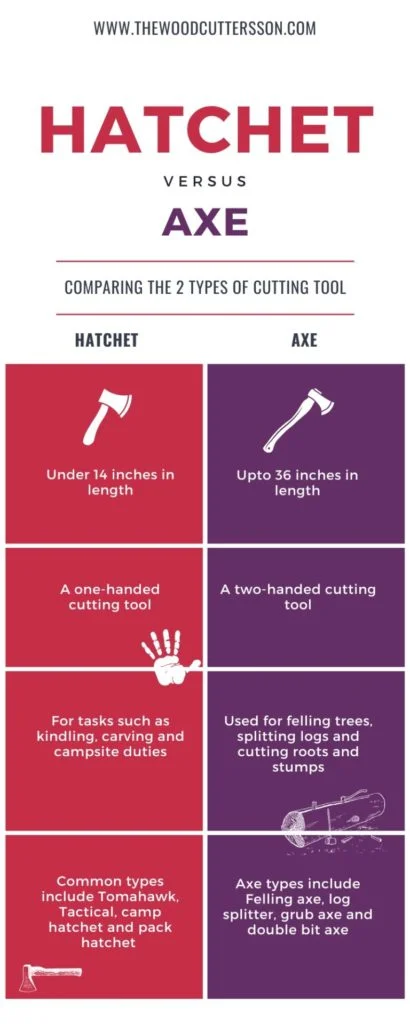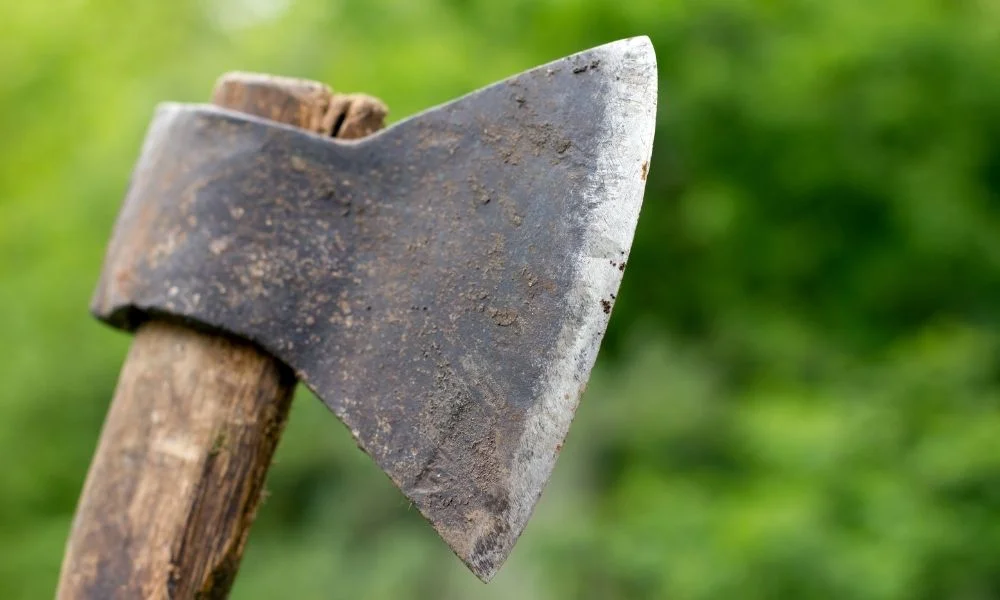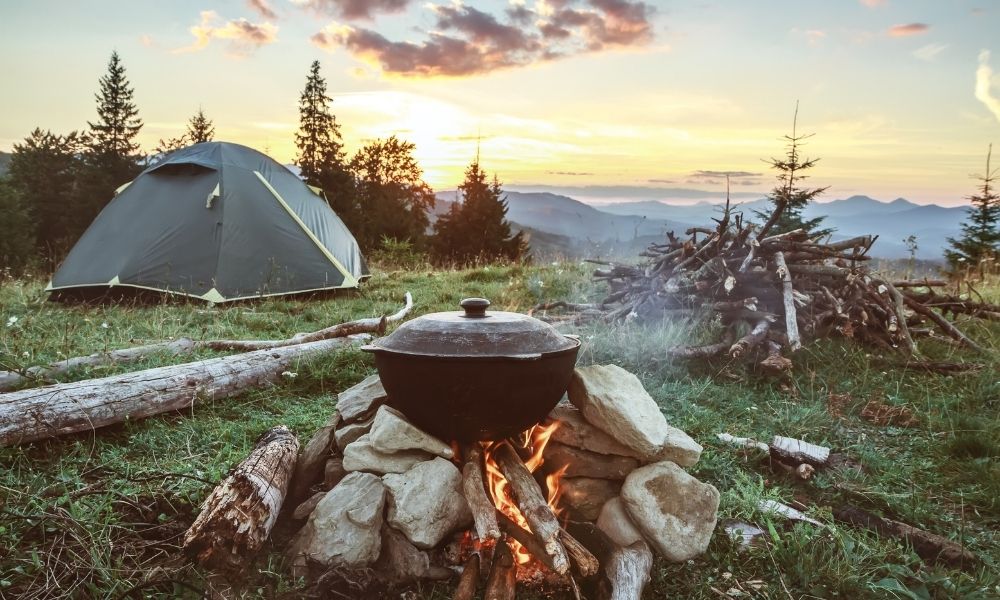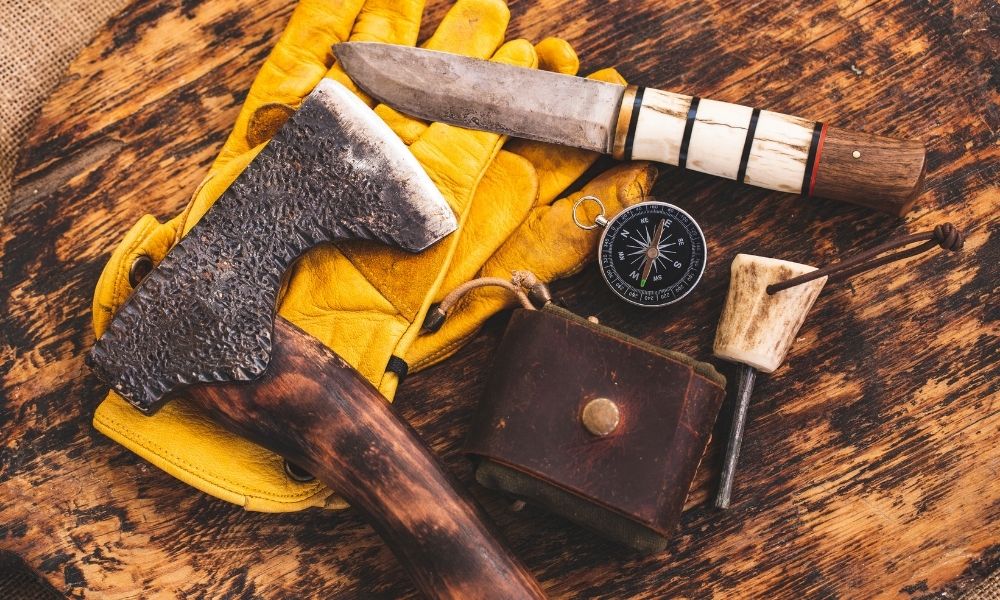Post Updated: 27 Feb 2023
A hatchet is a small, one-handed axe that is primarily used for light work such as kindling firewood, making tinder, clearing brush and performing menial campsite duties.
A good quality hatchet can also be used for chopping down or limbing small trees and branches. The average size of a hatchet is around 14 inches in length.
An axe is defined as a two-handed cutting tool with a heavy edged steel head fixed parallel to a wooden handle. It’s used for felling trees and chopping or splitting wood.
The humble axe is a versatile hand tool that has been used for over 30,000 years – harking way back to the stone age. Nowadays, specialist axes have been produced for specific tasks ranging from tree felling, log splitting, wood carving, game hunting, trekking, you name it.
The hatchet was born from the necessity for the light precision work that an axe does. Having a smaller, handier sized axe is preferable to using a big full-sized axe for kindling firewood.
TABLE OF CONTENTS:
Straight to the point – Hatchet vs Axe
A hatchet is a one-handed wood chopping tool approximately half the size of an axe. An axe is used with two hands and can generate more power for chopping or splitting wood.
Hatchet vs Axe [Infographic]

A hatchet is a the little bro of the mighty chopping axe. Smaller, lighter but just as important in the world of wood!
Should a hatchet be sharp?

Hatchets are an important wood-cutting tool. They have the precision of a one-handed cutting tool with the power of an axe. The blade of a hatchet should be kept razor-sharp to give optimum performance.
A hatchet is used for jobs similar to a bush knife or machete and should be capable of out-performing both. As with any axe, it’s vital you keep the bit sharp with regular honing of the blade.
Check out my article on How to Sharpen an Axe for a step by step guide on axe sharpening. This is a vital skill for any axe owner.
Axe vs Hatchet for camping

Any cutting or splitting task beyond kindling can be done much easier, faster, and safer with a full sized axe. The reason to downsize is for activities such as camping where space is limited and ease of carrying is a necessity.
Having a big axe in your camp would be ideal but not always practical. This is why we have small axes and hatchets! A good hatchet such as the Hults Bruk Jonaker Hatchet or even an inexpensive one like the Fiskars X7 is a handier option for camping.
Axe vs Hatchet for bushcraft

Axes are for felling and chopping trees, splitting firewood and building cabins. Hatchets are for making kindling and small pieces of firewood for camp, as well as limbing and notching branches for shelter building.
If you’re just starting out learning Bushcraft skills, you should start small. Venturing out into the forest with a full sized axe is fine closer to home, but ideally you’ll want a one-handed tool with some decent chopping power but also capable of the more precise close-up work that a big axe will struggle with.
Axe vs hatchet for survival

This ultimately comes down to portability. The survivor mentality is the bare necessities, the simple bare necessities… So smaller, lighter and efficient is the way to go. Yes, a big axe is more capable but far too cumbersome for a survivalist setting.
Even a standard hatchet may be too much. I’d recommend the Off Grid Survival Axe or the Stansport Para Hatchet for survival purposes. They both come equipped with extra functions that will make your life easier out in the wilderness.
What should I look for in a hatchet?
Firstly, stay away from hardware store hatchets. They are made from cheap materials and won’t last a day of serious work. A good hatchet should be well-balanced and have a good quality head. Cheaper axes use crappy steel which will dent and ding easily.
The best hatchets have hand-forged steel heads with a high carbon content. This makes the axe durable and less susceptible to damage and wear.
The hatchet handle should be either hickory or fibreglass depending on the brand but I always swear by a classic wooden handled axe.
Which is better a hatchet or machete?
Although a machete has better slashing capabilities due to its long blade, it is a fairly lightweight tool compared to a hatchet – a hatchet has much more chopping power.
A sharp hatchet will do much the same work as a machete with the added advantage of being able to chop thicker brush and small trees, and can also be used as a hammer for driving tent stakes for example.
For the jungle, a machete is the ideal tool for clearing a path through the dense vegetation, but for camping, hiking and general bushcraft a hatchet is a more versatile tool.
The decision between hatchet or machete will ultimately depend on the terrain. In the North American woods, you’ll still find plenty thick, dense underbrush, but nothing like a jungle environment. A hatchet will give you the means to limb bigger branches to assist with shelter building or splitting wood for fires. A machete, not so much.
Related Article: Which Is Best For Bushcraft – Hatchet or Machete?
In the southeast US, a machete is usually more desirable because of the thick underbrush common in that area, but it really is about assessing the environment before packing your tools.
The best idea is packing both! They are equally essential cutting tools with different capabilities, and the combined weight shouldn’t put too much strain on your pack.
Best Hatchets & Machetes
I’ve listed a few companion hatchets and machetes below that are ideal for your time in the wilderness:
- Best Machete for survival, hunting & camping – CRKT Parang Machete: 18 Inch
- Best Saw Machete – Gerber Gear Gator Machete
- Best Jungle Machete – Jungle Master JM-031B
- Best all purpose hatchet – Hults Bruk Almike Small Hatchet
- Best campers hatchet – Estwing Special Edition Camper’s 16″ Hatchet
- Best budget hatchet – Fiskars X7 Hatchet
Can you use a hatchet to chop wood?
A hatchet is a small one-handed axe. Axes are the primary tool for chopping wood, so a hatchet is ideal for chopping smaller trees or splitting smaller logs.
Your success will depend on the quality of your hatchet. As I’ve stated in other articles, a cheap hardware store hatchet will not last a day of chopping due to the sub-standard materials used, so you should always spend a bit more on a quality product.
This will avoid having to constantly deal with chips and dings in the blade of a crappy hatchet. That said, any axe requires regular upkeep to ensure the bit is kept at optimum sharpness.
What’s the difference between a tomahawk and a hatchet?
There are many theories on what the difference is between a hatchet and a tomahawk. After delving into the definitions, forum discussions and opinions on this subject, it’s safe to say that:
- A hatchet is a small axe with a broad cutting edge and a flat poll on the other end of the blade for striking or hammering.
- A tomahawk is a light axe used by American Indians as a weapon or tool. It has a thin blade with a rounded poll or spike on the other end.
Nowadays, hatchets and tomahawks are used interchangeably for almost the same purposes with the hatchet seen as a more heavy-duty tool.
Conclusion
Hatchets are a smaller version of a standard sized axe. Capable of the same tasks but on a smaller scale.

Leave a Reply